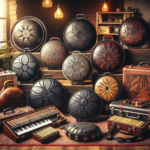<!DOCTYPE html>
<html lang="en">
<head>
<meta charset="UTF-8">
<meta name="viewport" content="width=device-width, initial-scale=1.0">
<title>Article on Next-Gen Handpans</title>
<style>
body {
font-family: Arial, sans-serif;
line-height: 1.6;
margin: 20px;
}
h2 {
color: #2C3E50;
}
p, li {
color: #34495E;
}
ul {
list-style-type: disc;
padding-left: 20px;
}
.faq {
margin-top: 30px;
}
</style>
</head>
<body>
<h2>Introduction</h2>
<p>
The mesmerizing sound of the handpan has captivated musicians and audiences alike since its introduction in the early 2000s. The instrument, known for its ethereal tones and unique playing style, has steadily gained popularity worldwide. As the demand for this captivating instrument grows, the development of next-gen handpans is pushing the boundaries of design and acoustics, heralding a new era for handpan enthusiasts.
</p>
<h2>The Evolution of Handpans</h2>
<p>
Invented by Felix Rohner and Sabina Schärer in Switzerland, the original handpan became famous for its UFO-like shape and celestial sound. Initially, handpans were crafted with minimal variations, using steel materials and a specific tuning process that limited options for tone and sound. Over the last two decades, advancements in technology and craftsmanship have led to multiple iterations and improvements, enhancing the instrument’s versatility and sonic possibilities.
</p>
<h2>Innovations in Material Usage</h2>
<p>
One of the key advancements in the development of next-gen handpans is the experimentation with different materials. Traditional handpans were typically made from nitrogen-hardened steel, which impacted the instrument’s timbre and resonance. Now, manufacturers are exploring alloys, stainless steel, and even synthetic materials to craft handpans that offer more durability, better corrosion resistance, and a broader acoustic range.
</p>
<p>
Research into new alloys has led to innovations that affect the way the instrument interacts with the environment, providing rich, sustained tones that are less susceptible to rust and wear. These sturdy materials ensure that the handpans can withstand diverse playing environments, from indoor studios to outdoor settings, without compromising auditory quality.
</p>
<h2>Enhanced Acoustic Capabilities</h2>
<p>
Sound innovation lies at the heart of next-gen handpan development. Manufacturers are continuously experimenting with the internal structure of the instrument, such as varying the thickness of the material or incorporating specialized patterns to create novel sound effects. These changes contribute to enhanced acoustics that offer a dynamic range of expressions for musicians.
</p>
<p>
Innovations in tuning techniques have expanded the variety of scales available, giving musicians the ability to explore new genres and styles. The new-age handpans can be tuned to chromatic scales, which deviate from traditional diatonic tunings, allowing for greater musical freedom and expression.
</p>
<h2>Design Enhancements</h2>
<p>
Beyond acoustics, the design of handpans has also seen considerable evolution. Modern handpans come with ergonomic designs that cater to a diverse range of players, from novices to seasoned musicians. The new generation of handpans features varied designs that enhance playability, such as altered dome heights and refined surface textures that contribute to improved tactile experience.
</p>
<p>
Aesthetic customizations have become popular among musicians, with manufacturers offering handpans that feature intricate engravings and color finishes. These decorative elements not only serve as visual statements but also reflect the artist’s unique personality and style.
</p>
<h2>Impact on the Music Community</h2>
<p>
With the advancements in the design and acoustics of handpans, the music community has witnessed a surge in creativity and collaboration. Musicians from various backgrounds are incorporating handpans into their compositions, exploring fusions of classical, jazz, and electronic music. As the instrument becomes more accessible due to improved manufacturing processes, an increasing number of artists are gravitating toward this unique sonic landscape.
</p>
<p>
The handpan community continues to thrive, fostering environments for learning, collaboration, and sharing across social media platforms and events. Online forums, workshops, and festivals dedicated to handpans provide valuable opportunities for musicians to connect and inspire each other with fresh ideas and approaches.
</p>
<h2>Conclusion</h2>
<p>
The evolution of handpans into next-gen instruments exemplifies the spirit of innovation and artistry within the music industry. By embracing advancements in materials, acoustic craftsmanship, and design, contemporary handpans are breaking the mold, offering musicians a vast spectrum of creative possibilities. As more artists integrate these instruments into their repertoire, handpans continue to push musical boundaries, playing an indispensable role in the future of sonic exploration.
</p>
<h2 class="faq">FAQs</h2>
<ul>
<li><strong>What makes next-gen handpans different from traditional handpans?</strong>
<p>Next-gen handpans incorporate advancements in materials, acoustic structures, and design. These innovations offer greater durability, a broader sonic range, and unique customization options that were not available in traditional models.</p>
</li>
<li><strong>Can next-gen handpans be used in any genre of music?</strong>
<p>Yes, thanks to expanded tuning options and acoustic capabilities, next-gen handpans can be integrated into a wide range of musical genres, including classical, jazz, electronic, and world music.</p>
</li>
<li><strong>Are next-gen handpans more durable than traditional handpans?</strong>
<p>Indeed, the use of new materials such as advanced alloys and stainless steel makes next-gen handpans more resistant to rust and wear, extending their lifespan and allowing them to withstand various playing environments.</p>
</li>
<li><strong>What design customizations are available with next-gen handpans?</strong>
<p>Design customizations include varied dome heights, ergonomic enhancements, intricate engravings, and color finishes, allowing musicians to choose instruments that suit their playing style and aesthetic preferences.</p>
</li>
<li><strong>How can musicians learn to play next-gen handpans?</strong>
<p>Musicians can learn to play next-gen handpans by attending workshops, engaging with online tutorials and communities, or taking lessons from experienced players. The growing handpan community provides numerous resources for musicians of all skill levels.</p>
</li>
</ul>
</body>
</html>Next-Gen Handpans: Pushing the Boundaries of Design and Acoustics

Leave a comment




